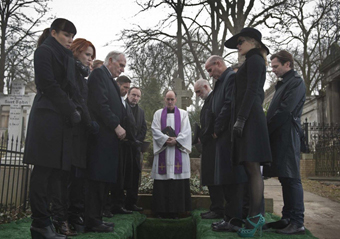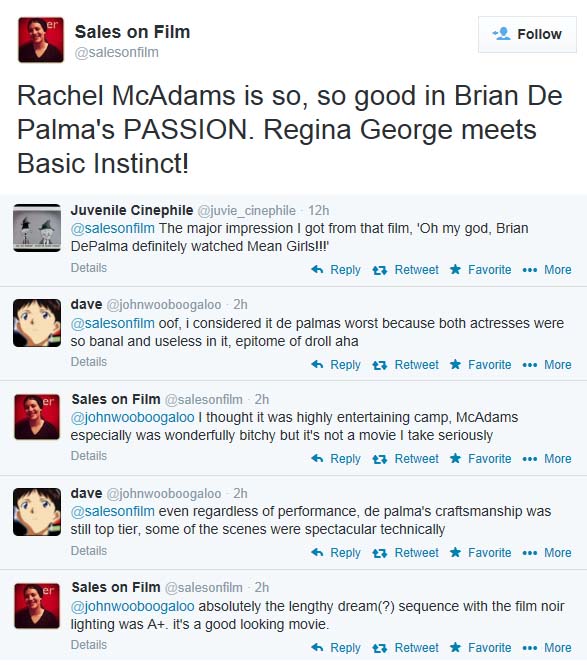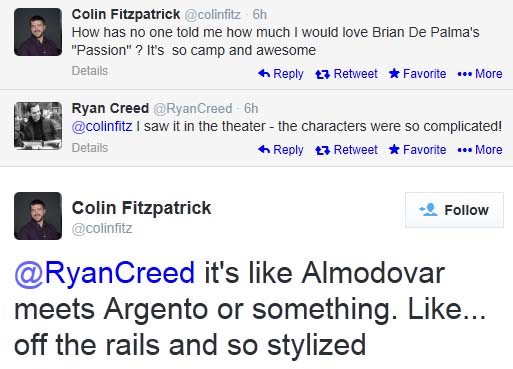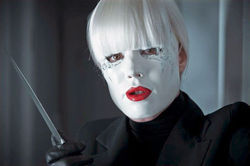INTERVIEW WITH UTE BERGK AT FILM COLOSSUS
 Ute Bergk, the set decorator on Brian De Palma's Passion, was interviewed recently by Travis Bean at Film Colossus. Bergk's work on Passion was the main focus of the discussion. Discussing how production on the film was on-and-off for years, Bergk tells Bean, "There was a point where [De Palma] was thinking, 'Oh, we’ll do it all in London.' And then I mentioned all the cars would be driving on the left side, and he didn’t like that at all."
Ute Bergk, the set decorator on Brian De Palma's Passion, was interviewed recently by Travis Bean at Film Colossus. Bergk's work on Passion was the main focus of the discussion. Discussing how production on the film was on-and-off for years, Bergk tells Bean, "There was a point where [De Palma] was thinking, 'Oh, we’ll do it all in London.' And then I mentioned all the cars would be driving on the left side, and he didn’t like that at all."I'm posting a lot of the highlights from the interview below, but you might as well just go read the entire thing at Film Colossus-- it's a very engaging interview, and is almost exclusively about Passion.
DURING THE OFF TIMES, DE PALMA REWORKED HIS STORYBOARDS, HAD EVERYTHING ALL PLANNED OUT
Discussing how she came to be the set decorator on Passion, Bergk tells Bean, "The Production Designer Cornelia Ott, who is a friend of mine, she got the script and got me involved, and we budgeted over and over and over again, because they couldn’t make up their minds where they wanted to shoot, and they had certain actors in mind that didn’t kick in at the right time, at the right point.
"So it was at least over a year before we got storyboards from Brian De Palma. Which were brilliant! He does them all himself. And it’s like a Bible. Because the film took so much time to kick off, he worked them over and over again, so when the filming finally started, it was so straightforward. He had it all planned out. It was fascinating. It was really precise.
"He’s one of these directors that just knows: he’s coming in in the morning, he’s not saying anything, and he’s working with people who he trusts for whatever reasons, and he’s just watching them work for a little while, and then he asks if everybody is ready, and he starts to shoot."
"HE KNOWS EXACTLY HOW THE ROOM WILL BE SET UP BEFORE HE GETS THERE"
A little later in the discussion, Bean asks, "So if Brian (is it OK if I call him Brian?) is coming on set and not talking to many people, is he talking to you? Or is it pre-planned, where he’s talking to you beforehand? Or is it more organic, where you get there and set things up?"
Bergk replies, "It’s very planned. He never arrives anywhere without expectations. He knows exactly how the room will be set up before he gets there. We would present it all in little models or sketches or photos. And for every location he would have a little folder, and we would explain, 'This is the sofa she sits on,' etc. Like in one of the offices, where you see the white arrangement of very sophisticated white leather sofas: 'This is where the Japanese board is going to sit.' Very rarely will he say, 'Oh, I don’t like this at all.' It’s usually the other way around. And because the arrangements are so classic, you kind of go that route and not allow yourself to be off stylistically. You don’t want to go overly pop, or overly sophisticated."
"YOU HAVE TO FIND JUST THE RIGHT STANDING LIGHT TO PLACE NEXT TO ISABEL'S BED"
In one enlightening passage of the interview, Bergk tells Bean about meeting with cinematographer José Luis Alcaine: "I remember that Jose came in, and obviously we did not know each other when we started, and that working relationship came into play very quickly. Because the moment Noomi (Rapace, playing Isabelle) was confirmed for the film, I got a call saying, 'We start prepping ASAP.' Now basically.
"And I said, 'Really? Finally?!'
"And of course, off we went, and Jose came in. José was always trying to discuss things with Brian, which was quite funny, because Brian would always make excuses, like, 'I’ve got to go to the dentist.' Because I think Brian totally trusted him and what he was going to do. So he didn’t want to control him whatsoever. And that was great. That’s why it was so good to work on this movie, because there was freedom.
"And so, I had this long meeting with José and went through all the practicals, which was quite important for the whole film, because, at that point, I wasn’t very knowledgeable of Brian De Palma and unaware of how important all of that is. Because there are sequences, for example, where the entire scene is basically lit by the practicals. And if you see the two different offices (Isabelle and Christine, played by Rachel McAdams), one is white, and one is white-and-black. And if you look closer at what there is in terms of practicals, it’s totally different.
"We had this glass desk in Christine’s office because we wanted to see her legs. And it’s all very sexy and round…and a bit bitchy. Isabelle’s office is the other way around: it’s all very cruel, almost frozen. You see this black, bold standing light in the background, which is pretty much what I thought was her. And it’s a very complicated light fitting because it’s lit in a very complicated way, but José liked it because, for all the dream sequences, he used this black-and-white lighting, which that light fixture naturally gives him.
"And that was a very interesting discussion! I’d never had that before. But obviously that was so important for the whole film. The more time you spend with these guys, the more you get into it. You learn what’s important, that you have to find just the right standing light to place next to Isabel’s bed during her dream sequence. That took me weeks to find!"
"IF YOU WORK WITH BRIAN DE PALMA, YOU KNOW THAT YOU HAVE TO HAVE MIRRORS"
When asked by Bean where she went to find decorations for Passion, Bergk replies, "It depends where you are. Passion was shot in Berlin, and we didn’t shoot many sets in the studio. We built a few additions to existing locations, and we’d incorporate architectural details. But the thing with Berlin is: it’s not such an advanced industry, as it is in London [where Bergk resides]. Berlin does not really have facilities.
"So, for Passion, it was all very contemporary. It’s not like you had to do lots of research into some period details. It was contemporary, it was very classic. If you work with Brian De Palma, you know that you have to have mirrors. You will see the ceiling, which is very unusual, because a lot of directors don’t show the ceiling in movies at all. So that’s a very interesting research subject actually: who is looking up in the film?
"And because the style was contemporary, most of the stuff you see is available in shops. It’s very high-class furnishing. In the first scene you see a sofa in Christine’s apartment, and that’s one I had made, which was possibly the most expensive piece of furnishing in the entire film. But I thought it was worth it—there was something existing and I adopted it, changing its color and shape. This kind of film is not rough. It’s a very delicate film.
"There’s this nice sequence where they’re sitting in front of a huge television and a character gets drunk, and he gets drunk on a Fendi, a luxurious settee—and it is so uncomfortable. I saw it in an exhibition. To sit on it is fine, but to get drunk on it is very uncomfortable. It’s not like a sofa that you fall into. And he was supposed to fall into it, but he couldn’t because it has wooden a frame. So when he does fall into it, he makes this sounds like [insert uncomfortable *oomph* sound effect], which is exactly what was needed for this sequence. So that was a good find."
THE BALLET SEQUENCE
The interview ends with a discussion of the ballet sequence in Passion:
Travis I feel obligated to ask about the ballet sequence, just because it makes me giggle with excitement every time I watch it. I know in the actual ballet studio, there isn’t a lot in there, it’s mostly blue and white walls. Did you contribute anything specific to that sequence? Working with the idea that it would be displayed partly on a split-screen? Or that there would be a lot of empty space to deal with?
Ute Bergk It was actually more of the other way around. I sent you a video, did you get it?
Travis Yeah yeah, I watched it!
Ute Bergk That was the original version of the performance. There’s a foundation behind it, and you are very much controlled by this foundation. The choreographer came over from the States and she was very controlling about everything. If you see, in the black and white footage I sent you, in the beginning, the curtain is on a pole and goes up, above the stage, which is where we shot. It was quite difficult to do, because we had this theater setting and everything just goes up, and not up and around. And we had to do it that way. They had to see that pole going up. So we had to build a structure to do that with.
Basically, you have to find the right materials. We had to slim it down because we shot it on a quiet part of the stage, which is in the Renaissance Theater, which is not big at all. So there was a model built that was put into this existing space. And to drape white fabric without having any frills in it is not easy.
The whole ballet sequence—we knew it would be very important, so we shot it for three days in that theater with those two wonderful dancers. And it was crystal clear that the stage design at that point was part of what the story tells. And specifically, in that performance, the audience is the mirror. They dance behind their exercise rails to warm up, and what is behind is basically nothing. It’s like a rehearsel room. And all you see is the door they come in and a window. And that’s all. The rest is up to them. And that was as simple as is. Brian, at that point, was just focused on the dancers.
Travis Well definitely. They’re looking right into the camera, and effectively looking right at you. I’m fascinated by that aspect of the film. Not only the characters are being watched—he’s looking right at the audience and acknowledging their presence in the movie.
Ute Bergk It was a very artistic approach, obviously. To have the audience as the third part, see that in certain kinds of artwork, like Manet’s paintings for example. The artist plays with the subject as well. So it’s very interesting to address it in that way—it’s a very De Palma style of filmmaking to address the audience. And then the split screen…I still get goosebumps thinking about it.




 Christopher Cole has written a terrifically insightful piece at
Christopher Cole has written a terrifically insightful piece at 
 Brian De Palma's Passion has made yet another list of the best films of 2013, this one from a "ragtag band of scattered cinephiles" that strives to "recognize noteworthy achievements from the previous year in cinema, unswayed by awards-season hype." Together, they vote for the
Brian De Palma's Passion has made yet another list of the best films of 2013, this one from a "ragtag band of scattered cinephiles" that strives to "recognize noteworthy achievements from the previous year in cinema, unswayed by awards-season hype." Together, they vote for the 


 Brian De Palma's Passion will be included as part of a film series at the
Brian De Palma's Passion will be included as part of a film series at the 
